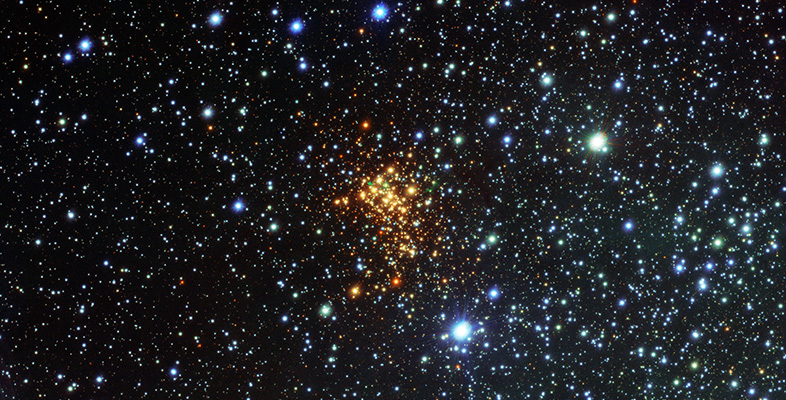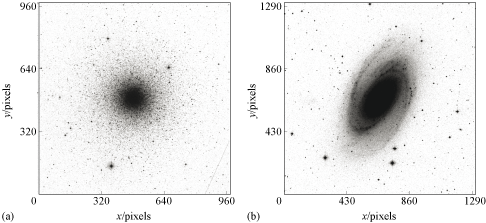1.3 Measuring sizes
With a few exceptions (the Sun, and a few nearby red giant stars), we cannot measure the sizes of individual stars. The observed size of a star in an image is determined by the PSF and is typically much larger than the true size. But much of our knowledge of systems of stars – binary stars and stellar clusters, star-forming regions and galaxies – is built on measurements of their sizes, as calculated from astronomical images.
The size measured directly from an image does not on its own tell us about its true physical size. We initially measure angular size, the angle the object spans on the sky, but we need to know its distance to determine how big it is in kilometres or parsecs.
Figure 5 shows two images taken by the same telescope as part of the Digitized Sky Survey project. On the left is a globular cluster and on the right is a nearby galaxy. The two objects span a similar number of pixels on the Survey’s CCD detector.
-
Using an astronomy software tool, the star cluster and galaxy are measured to span 540 pixels and 900 pixels, respectively. What additional information would you need in order to compare the true sizes of the two astronomical objects?
-
You would need a way to convert between pixels and angle on the sky. You also need to know the distances to each of the two objects.
The conversion factor between pixels and angular size or separation in arcseconds or arcminutes will be different for different telescopes. It is known as the telescope’s pixel scale.
Example 1
Imagine that you read the documentation for the Digitized Sky Survey 2, the source of these images, and find that the pixel scale is 0.0170 arcmin pix−1. Calculate the angular size of the globular cluster.
Solution
The angular size is given by multiplying the size measured in pixels by the pixel scale of the telescope detector. The angular size is therefore:
The globular cluster has an angular size of 9.18 arcminutes.
-
Repeat the calculation in relation to Example 1 to determine the angular size of the galaxy in Figure 5b.
-
900 pixels × 0.0170 arcmin pix−1 = 15.3 arcmin
The galaxy has an angular size of 15.3 arcminutes.
You research the star cluster and the galaxy (e.g. by looking up their names on the SIMBAD astronomical database), and discover that the cluster is at a distance of 10.4 kpc (it is within the Milky Way), while the galaxy is at a distance of 2.6 Mpc.
Converting an angular size of an object into a physical size is a straightforward trigonometrical calculation, as long as we know the distance to the objects. The equation relating these quantities is
Where is the angular size, D is the physical size and d is the distance to the object. It is also useful to recognise that, for small angles measured in radians, .
-
Now calculate the physical sizes of the two objects, and compare them. (Hint: if you are stuck, you may wish to review the information above this question.)
-
The cluster’s angular size in radians is
The small-angle approximation discussed previously (, where ) applies both to angular separations and angular sizes. Hence the cluster’s physical size () is related to its angular separation () and its distance () by
A similar calculation for the galaxy gives a physical size of 11.6 kpc. Therefore the galaxy is around 400 times larger than the star cluster.

